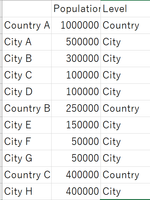FabCon is coming to Atlanta
Join us at FabCon Atlanta from March 16 - 20, 2026, for the ultimate Fabric, Power BI, AI and SQL community-led event. Save $200 with code FABCOMM.
Register now!- Power BI forums
- Get Help with Power BI
- Desktop
- Service
- Report Server
- Power Query
- Mobile Apps
- Developer
- DAX Commands and Tips
- Custom Visuals Development Discussion
- Health and Life Sciences
- Power BI Spanish forums
- Translated Spanish Desktop
- Training and Consulting
- Instructor Led Training
- Dashboard in a Day for Women, by Women
- Galleries
- Data Stories Gallery
- Themes Gallery
- Contests Gallery
- QuickViz Gallery
- Quick Measures Gallery
- Visual Calculations Gallery
- Notebook Gallery
- Translytical Task Flow Gallery
- TMDL Gallery
- R Script Showcase
- Webinars and Video Gallery
- Ideas
- Custom Visuals Ideas (read-only)
- Issues
- Issues
- Events
- Upcoming Events
The Power BI Data Visualization World Championships is back! Get ahead of the game and start preparing now! Learn more
- Power BI forums
- Forums
- Get Help with Power BI
- Desktop
- Help: Using earlier row values as condition
- Subscribe to RSS Feed
- Mark Topic as New
- Mark Topic as Read
- Float this Topic for Current User
- Bookmark
- Subscribe
- Printer Friendly Page
- Mark as New
- Bookmark
- Subscribe
- Mute
- Subscribe to RSS Feed
- Permalink
- Report Inappropriate Content
Help: Using earlier row values as condition
Sorry if the question title sounds confusing; I'm not really sure how to phrase it nicely. It's my first time doing this kind of work so due apologies if anything is phrased confusingly.
I have a table in PowerBI that combines both aggregated and individual data. An example dataset is as such:
I'd like to add a column that references the country each City/Country belongs to, as such:
But I don't really know how to find the nearest earlier row that contains "Country" as the categorical value. Is there any way to do this in a calculated column via DAX?
On a separate note, I can split the tables up into a City and Country table, but because there are a lot of duplicates in the City Table I'd like to avoid that if possible.
Solved! Go to Solution.
- Mark as New
- Bookmark
- Subscribe
- Mute
- Subscribe to RSS Feed
- Permalink
- Report Inappropriate Content
This is the kind of data shaping to be done with M (Power Query), not with DAX.
In "Edit queries", add column "Country" with formula
if [CountryOrCity] = "Country" then [Location] else null
Next, go to the Tranform tab, make sure the new Country column is selected, and choose Fill - Fill Down.
- Mark as New
- Bookmark
- Subscribe
- Mute
- Subscribe to RSS Feed
- Permalink
- Report Inappropriate Content
This is the kind of data shaping to be done with M (Power Query), not with DAX.
In "Edit queries", add column "Country" with formula
if [CountryOrCity] = "Country" then [Location] else null
Next, go to the Tranform tab, make sure the new Country column is selected, and choose Fill - Fill Down.
- Mark as New
- Bookmark
- Subscribe
- Mute
- Subscribe to RSS Feed
- Permalink
- Report Inappropriate Content
Thanks for the help! I originally derived the Country/City column as a calculated column so doing it via Power Query wasn't intuitive to me but your answer brought me back to the right track.
On a separate note, does that also mean that there is no good way of doing this via a calculated column rather than via M?
- Mark as New
- Bookmark
- Subscribe
- Mute
- Subscribe to RSS Feed
- Permalink
- Report Inappropriate Content
In my view, it is not a good way to do it in DAX.
Then again, it might still be possible in DAX, but that's not my expertise, so I just don't know and I leave the answer to that question to the DAX experts over here.
Helpful resources

Power BI Dataviz World Championships
The Power BI Data Visualization World Championships is back! Get ahead of the game and start preparing now!

| User | Count |
|---|---|
| 39 | |
| 37 | |
| 33 | |
| 32 | |
| 29 |
| User | Count |
|---|---|
| 133 | |
| 88 | |
| 85 | |
| 68 | |
| 64 |



